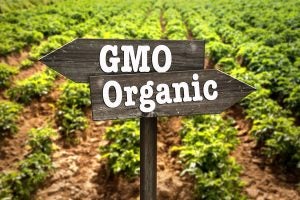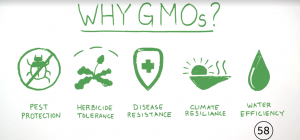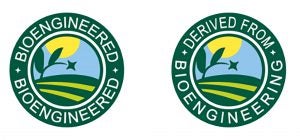The mandatory compliance date for the new U.S. Department of Agriculture’s National Bioengineered (BE) Food Disclosure Law is effective January 1, 2022. The law, passed by Congress in July of 2016, directed the USDA to establish this national mandatory standard for disclosing foods that are or may be bioengineered.
Although you may be familiar with the Non-GMO Project verified label, this bioengineered label is something separate from that. You may have already started seeing the BE food disclosure on food packages since many companies have already begun to implement it. So, what does it mean and how does it differ from the Non-GMO Project Verified label?

Here are some of the biggest differences between the two labels:
The BE label is mandatory, unlike the non-GMO label
The non-GMO label is a pay-to-play label: Companies pay the Non-GMO Project a yearly fee as well as a per product fee for product verification and to be able to use the label on their package.
The BE label is mandatory. Regulated entities must comply with the National Bioengineered Food Disclosure Standard (NBFDS). The standard defines regulated entities as food manufacturers, importers, and certain retailers who label food for retail sale.
The Non-GMO Project’s definition of ‘GMO’ is similar to the USDA’s definition of ‘bioengineered’
A GMO, or genetically modified organism, is defined by the Non-GMO Project as a plant, animal, microorganism or other organism whose genetic makeup has been modified in a laboratory using genetic engineering or transgenic technology. This creates combinations of plant, animal, bacterial and virus genes that do not occur in nature or through traditional crossbreeding methods.

Rather than “GMO,” the NBFDS uses the term “bioengineered,” which is a more scientifically accurate term. The NBFDS defines bioengineered foods as those that contain detectable genetic material that has been modified through in vitro recombinant deoxyribonucleic acid (rDNA) techniques and for which the modification could not otherwise be obtained through conventional breeding or found in nature.
Although the definitions are similar, there are some key differences in what foods are considered GMO vs. what foods are considered bioengineered
The Non-GMO Project has determined a “High-Risk List,” which is a list of crops and inputs that are highly likely to be genetically modified. These high risk crops are: Alfalfa, canola, corn (except popcorn), cotton, papaya, soy, sugar beet, zucchini and yellow summer squash, potato, apple, eggplant and pineapple.
Some of these crops are testable, meaning the raw source material can be tested to prove that it is non-GMO, while others are not detectable by current tests. Human food products can have up to 0.9 percent GMO and still qualify for the non-GMO label.
A product containing ingredients derived from the GMO versions of any of these crops wouldn’t qualify for the non-GMO label. This is the case even for a highly refined product like soybean oil, for example, that likely wouldn’t contain a detectable level of genetic material. So, even though the product itself isn’t necessarily genetically modified (because it has no genes after refining), it wouldn’t be able to be verified.

In addition, food products made up of only ingredients that don’t have a GMO counterpart can qualify for the non-GMO label. So, a shaker of sodium chloride with no additional ingredients could be non-GMO verified and sport the label despite salt not having any genes to modify. Animal derivatives such as meat, dairy, eggs, honey, seafood are also considered “high-risk” due to the prevalence of GMOs in animal feed. Therefore, if a food product contains meat, for example, from an animal that ate GMO feed, it cannot qualify for the Non-GMO Project verified label. This is, of course, despite the fact that animals digest food, so there’s no way to test animal derivatives to know whether the animal ate GMO feed during its lifetime or not.
Alternatively, the NBFDS only applies to human food that is subject to the labeling requirements under the Federal Food, Drug, and Cosmetic Act (FDCA). The Agricultural Marketing Service (AMS) developed the List of Bioengineered Foods to identify the crops or foods that are available in a bioengineered form throughout the world and for which regulated entities must maintain records. Since new BE products continue to be developed, AMS will review the list annually and, if necessary, make updates through the federal rulemaking process.
The current BE foods include alfalfa, apple (Arctic varieties), canola, corn, cotton, eggplant (BARI Bt Begun varieties), papaya (ringspot virus-resistant varieties), pineapple (pink flesh varieties), potato, salmon (AquAdvantage), soybean, squash (summer) and sugarbeet.
Ingredients or products in which modified genetic material is not detectable are exempt from the disclosure labeling (i.e. refined sugars and oils from BE sources). So, although refined soybean oil that is derived from BE soybeans would be considered “GMO” per the Non-GMO Project, it would not be considered BE if there is no detectable genetic material, thus, would not require a BE food disclosure.
Another difference from the non-GMO label is that the NBFDS states that food produced from an animal fed BE feed is not considered a BE food solely because the animal ate a BE feed. For example, the milk from a cow that ate BE alfalfa is not considered a BE food just because the cow ate BE alfalfa, thus, would not require a BE food disclosure.

Foods that are subject to the labeling requirements under the Federal Meat Inspection Act, the Poultry Products Inspection Act or the Egg Products Inspection Act only require a BE disclosure if the predominant ingredient would be independently subject to labeling under the FDCA, or if the predominant ingredient is broth, stock, water or similar solution and the second most predominant ingredient would independently be subject to labeling under the FDCA. A disclosure is not required for foods in which no ingredient intentionally contains a bioengineered substance, with an allowance for inadvertent or technically unavoidable bioengineered presence of up to 5 percent for each ingredient.
This threshold exemption recognizes the complexities of the supply chain and acknowledges that BE and non-BE foods may be harvested by and processed on the same equipment. This exemption does not apply to highly refined BE foods where detectable modified genetic material is present.
How are bioengineered foods labeled?
You will see “bioengineered food” or “contains bioengineered food ingredients,” a color or black and white symbol (see the image below), scannable links, text message instructions, or in some cases phone numbers or web addresses that convey the information.
Entities can make specific voluntary disclosures for foods that do not contain detectable modified genetic material. These are not BE foods, but they may carry a symbol that states “Derived from Bioengineering,” or that otherwise disclose the product contains ingredients “derived from bioengineering.”

BE food labels are not required for food produced by very small food manufacturers, and food served in restaurants, food trucks, trains, airplanes, delicatessens and in similar establishments, even if the product has bioengineered ingredients.
Keep in mind that both a bioengineered food disclosure and a non-GMO label are marketing labels, and they do not convey any information about the health, safety, or environmental attributes of bioengineered or GMO food as compared to non-bioengineered or non-GMO counterparts.
It could be very eye-opening to consumers once the NBFDS is fully implemented just how many products won’t require the bioengineered label. The non-GMO label leads consumers to believe that products without the non-GMO label must, by default, be GMO. They will soon find out that this isn’t the case. A lot of the negative press surrounding “GMOs” is largely untrue, and according to a 2019 study, the more strongly people report being opposed to GM foods, the more knowledgeable they think they are on the topic, but the lower they score on an actual knowledge test.
Hopefully the bioengineered label and messaging around it will help to educate consumers about the safety of bioengineered foods, after all, they are just as safe and at least as nutritious as their non-bioengineered counterparts.
Food Science Babe is the pseudonym of an agvocate and writer who focuses specifically on the science behind our food. She has a degree in chemical engineering and has worked in the food industry for more than decade, both in the conventional and in the natural/organic sectors.



